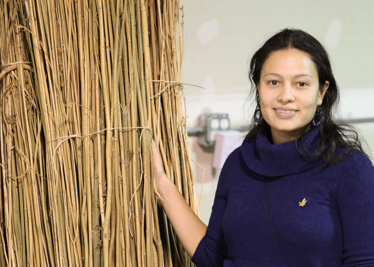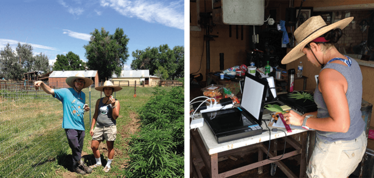Breeding Better Buds
An Interview with Daniela Vergara, postdoctoral researcher at the University of Colorado, Founder and President of the Agricultural Genomics Foundation, and co-Founder of the Cannabis Genomic Research Institute, Boulder, CO, USA.

After gaining a PhD in evolutionary biology, I joined Nolan Kane’s group at the University of Colorado. The lab works with many agricultural crops, such as sunflowers, chocolate and mustard. Initially, I planned to work on sunflowers, but given that cannabis is an increasingly important crop, we decided to try applying evolutionary biology techniques to cannabis instead.
Cannabis is one of man’s oldest crops, and yet we know much less about it than other cultivated plants. What we are proposing to do in cannabis was done long ago in wheat, soy, and tomatoes. All of the techniques and tools we’re using have been developed in other crops – the only difference is that cannabis is federally illegal, which makes it challenging to get funding. Our group, known as the Cannabis Genomic Research Initiative (http://cannabisgenomics.org/), has an associated non-profit, the Agricultural Genomics Foundation (http://www.agriculturalgenomics.org/), which supports our work to better understand the biology of cannabis.
We are applying next-generation sequencing to investigate the genetics of cannabis, using shotgun sequencing and genotyping-by-sequencing technology from Illumina. The cannabis genome was published in 2011 by a Canadian group, but we want to add to the sequence data by mapping the physical location of genes across the chromosomes. You could say that the genome sequence on its own is like a book with the pages inserted at random; a genomic map will let us order the pages, and make it much easier to read.
We are also collaborating with analytical scientists at Steep Hill Labs to compare the genomes of different strains with the levels of different cannabinoids – to link genotype with phenotype.
One of our most interesting studies so far was a comparison of the cannabis being sold in dispensaries and the cannabis supplied for research from the National Institute on Drug Abuse (NIDA). We found that cannabis on the private market is much more varied and has much higher potency than NIDA-supplied cannabis (http://www.biorxiv.org/content/early/2016/10/26/083444). The cannabis industry has been carefully refining their strains and growing methods over time, so that their product is now far stronger than the government weed. Clearly, NIDA cannabis being used for research across the country is not representative of the cannabis being sold for medical or recreational use. This is a real concern – if the cannabis being used in medical research is not what patients are taking in the real-world, how can we expect reliable results?
Another interesting finding has been that strains are not always related in the way that growers or consumers might expect. For example, you could have two strains with very similar names, which are very loosely related. The plants are often not even the species they are thought to be – C. sativa often turns out to be C. indica, and so on.

How will understanding the genetics of cannabis help the industry on a practical level? For one thing, it makes it easier to create varieties with specific traits; for example, high CBD or drought tolerance. What makes selective breeding of cannabis so difficult is the immense variation in the cannabis genome – there is more variation between cannabis varieties than there is between humans and chimpanzees. That means that even two sibling plants can have radically different properties, and simply crossing two plants with desirable traits may not get the result you want. You might cross an unusually tall plant with one that smells strongly of lemons, but you have a long wait until the offspring reach maturity, and no guarantee that they will be either tall or lemon-scented! By mapping the genome, we can predict the traits of the offspring and guide breeding efforts.
When we talk about understanding the genetics of cannabis, some people assume we want to create genetically modified plants. In fact, cannabis has so much variation that the traits we want will almost certainly be found somewhere in nature, so there is no need to add genes from other species. We just need to be smart with what plants we’re crossing, but without a full understanding of the genetics, that’s hard.

It takes time to change attitudes. Most in the industry are very supportive of what we do, but others want immediate results; they don’t understand that breeding programs take time. Some growers are quite hostile to our work – I’m a 5’1” Latino woman, and sometimes when I tell a guy who’s been growing hemp since the 1960s that we need to do things differently, he doesn’t take it too well. They can see it as interfering with nature, and think we are going to produce GMO cannabis. But most people can see that I am passionate about the potential of cannabis as an agricultural crop, and as a medicine. I believe that better breeding programs will ultimately benefit patients – mothers of children with epilepsy, veterans with PTSD, and many others.












